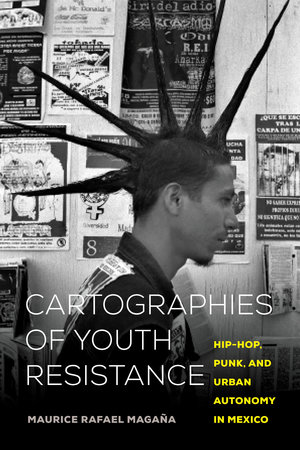Magaña, Maurice Rafael. Cartographies of Youth Resistance: Hip Hop, Punk, and Urban Autonomy in Mexico. University of California Press, 2020.

Maurice Rafael Magaña is a sociocultural anthropologist known for his research in urban space, social movements, and the cultural politics of youth organizing. In his book Cartographies of Youth Resistance: Hip Hop, Punk, and Urban Autonomy in Mexico, Magaña looks at the role that urban youth (whom he terms the 2006 generation) played in shaping Oaxaca city both during and after the 2006 social movement. This book provides us with the knowledge that is necessary to understand how the most marginalized in society (indigenous and migrant youth) navigate infrapolitics. Infrapolitics is a term coined by James C. Scott (1990) to describe the invisible struggles that marginalized groups engage in daily, and how they are able to see a more equitable society forthcoming through the spaces that exist between the extraordinary social movements and the everyday mundane. Magaña focuses on how youth reclaim public space by introducing the concept of the palimpsest, which is how indigenous and migrant youth are able to carve out their own space and be heard while living in a terrain of violence, colonialism, and capitalist influence. One of the core concerns across all chapters of this book is the occupation of counterspaces, and the important role these spaces played for political actors.
One of the most interesting parts of this book was the role that women played in the movement, in particular “the march of the pots and pans” which led to their occupation of channel 9; a state run radio and television station. This was interesting as it added a gendered aspect to the book because women used the radio as an outlet to challenge the masculine voice of the movement. During their occupation, they renamed the station “Radio Cacerola”, and this counterspace that they created not only challenged hierarchies of sex and gender, but also sexuality, race, age, class, and ethnicity. A challenging topic addressed by Magaña was the discussion surrounding tourism in Oaxaca city and how the urban poor and working class are pushed to the margins of the city to cater to tourists. The areas where they were pushed lacked basic services. While economic benefits are highlighted by showing how some artists have capitalized on tourism, it hinders social movements as the upper class attempts to stifle it in the pursuit of economic profit. From this, the text provokes the reader to reflect on their own social awareness of the spaces they have or will in future occupy as a tourist
Cartographies of Youth Resistance would appeal to readers involved or interested in social movements, as well as young people because of its study of political protests and revolution, and the important role that urban youth had in changing the social climate in Oaxaca city. It is inspiring to see the impact that the urban youth had in Oaxaca city, especially in times when young people feel that they don’t possess the power to enact change. This book highlights that the voices and actions of marginalized populations in society do matter and can promote social change.
- Megan Watson
